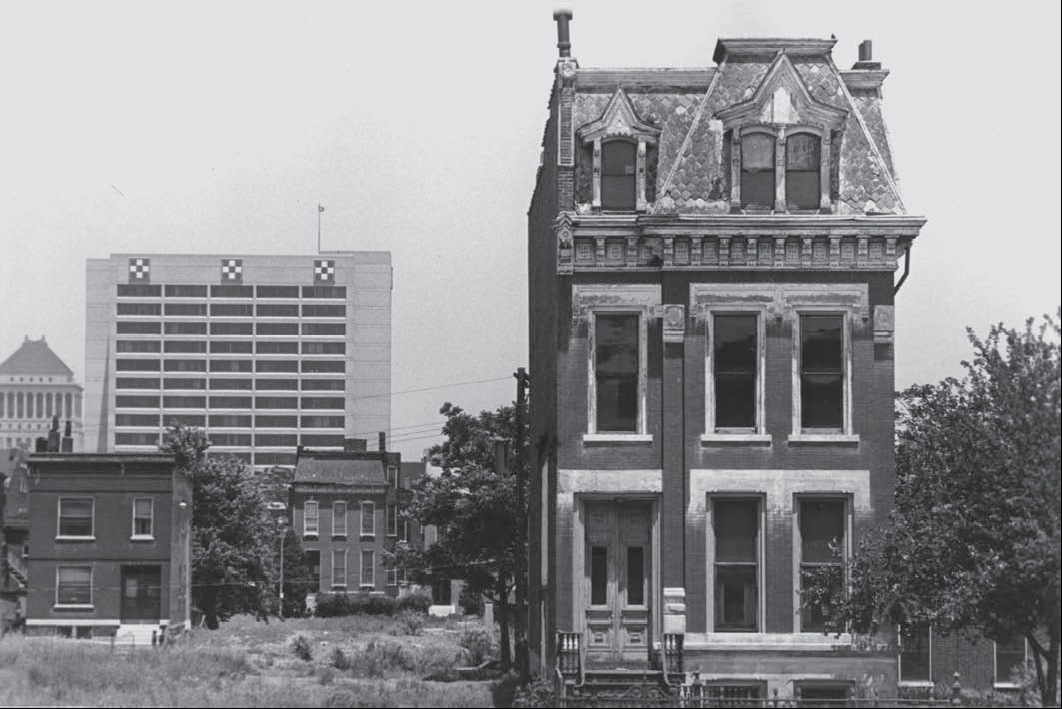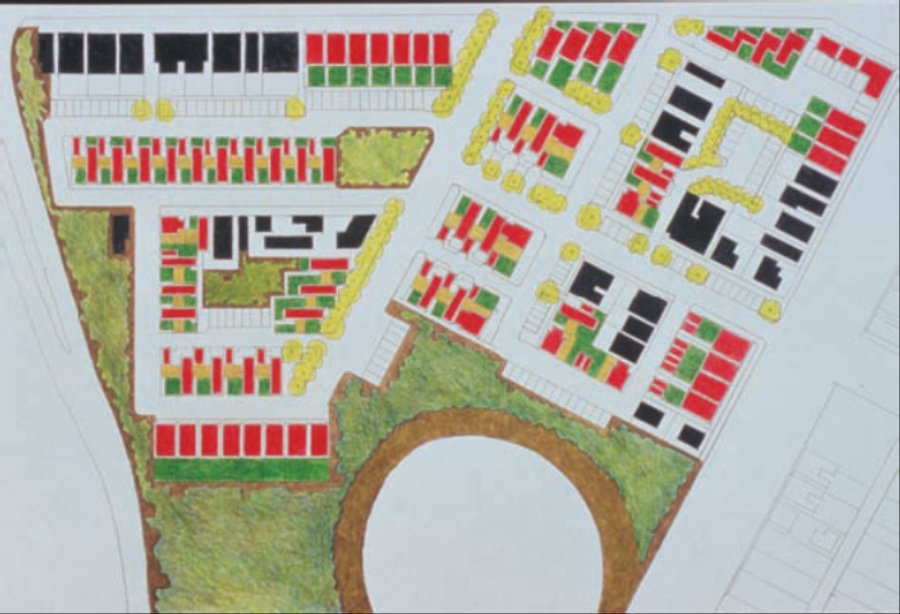Bohemian Hill
LaSalle Park in 1975 with 911 Park at the right.
Kitty-corner from St. John Nepomuk Church on the near south side lies what is left of Bohemian Hill. Once home to 19th century eastern European immigrants, the neighborhood in the 1950s was subjected to the twin assaults of urban renewal for Darst-Webbe public housing (razed 1999) and clearance for merging interstate highways. Soon, the truncated adjoining neighborhoods of Soulard and Lafayette Square were experiencing substantial deterioration and abandonment. Fortunately, a handful of far-sighted preservationists acquired property, put together neighborhood organizations and enlisted the help of the Missouri State Office of Historic Preservation, LANDMARKS and the National Trust for Historic Preservation. By the end of 1972, successful National Register nominations had been completed for Soulard, Lafayette Square and the St. John Nepomuk parish complex and both LANDMARKS and the National Trust were contributing money to revolving fund activities.
Next, LANDMARKS and SNIA (Soulard Neighborhood Improvement Association, later Youth, Education & Health in Soulard, YEHS) took on the lingering Urban Renewal project in LaSalle Park (the corporate headquarters of Ralston Purina). After a brief period of confrontation, Ralston and the City administration were convinced to redirect the project (located adjacent to Soulard and Lafayette Square) from clearance to rehabilitation. Ralston even donated the bedraggled High Victorian house (see above) at 911 Park to LANDMARKS for a Bi-Centennial project! This dramatic modification earned Ralston seven pages in a prestigious 1978 publication, Business and Preservation. The company’s redevelopment team led by Fred Perabo would go on to receive the national George S. Dively Award for corporate leadership in 1984.
In 1980-81, YEHS acquired six Bohemian Hill structures between Tucker and 13th Street in order to produce 22 units of affordable rental housing though the moderate rehab Section 8 program; by 1983, LANDMARKS’ National Register nomination had documented the remaining historic resources in LaSalle Park east of Tucker between Chouteau and the 3rd Street Expressway. Omitted from that the nomination, however, was the remaining segment of Bohemian Hill –– by now an enclave of scattered historic resources isolated by major streets (Tucker and Lafayette) and freeway interchanges.
As renovation continued in Lafayette Square, Soulard and LaSalle Park, it became obvious that a revived Bohemian Hill could provide the missing link between those historic neighborhoods. The site also offered a perfect opportunity to develop concepts for contemporary infill houses—a project of longstanding interest to your editor. Preliminary ideas from a WU graduate student studio directed by LANDMARKS’ Carolyn Toft, YEHS’ Bob Brandhorst and architect/professor Don Royse were presented during Preservation Week 1998 in cooperation with St. John Nepomuk and the Home Builders Association of Greater St. Louis. Soon thereafter, YEHS received a grant from the Missouri Department of Economic Development to produce housing (both new and rehab) and involve students in YouthBuild—a program offering at-risk youth a GED as well as hands-on experience in the building trades.
| Original Royse/Noero site plan from 1999 with existing buildings in black and infill in red. Note: Lafayette at the top and Tucker at the right. |
To move the project from concept to reality, architects Don Royse and Jo Noero from Washington University were hired to create an overall site plan (see above), develop schematic designs for several prototype infill houses, provide working drawings for the first few to be constructed and build models to demonstrate the overall concept. A vacant storefront space at 1924 South 12th Street in nearby Soulard was fitted out as a project office where the design team could work and hold meetings about the project. Informal sessions on Thursday mornings brought together representatives from nearby neighborhoods, city officials and consultants, politicians, builders, corporate executives and interested media. One such meeting resulted in a Post-Dispatch feature story (January 6, 1999) by Sue Ann Wood.
Comptroller Darlene Green at “Raise the Roof’” in 1999 with YouthBuild construction crew and model of the new houses. Landmarks’ Photo.
Although the overriding design challenge at Bohemian Hill was to demonstrate how superior contemporary design could fit comfortably within historic contexts, an immediate need was to stabilize the 25 existing buildings and develop an environmentally sophisticated site plan with unique amenities. Funding from the Regional Housing & Community Development Alliance (RHCDA, a non-profit organization providing technical assistance for community-based development) allowed the design team to refine the site plan and begin work on additional housing prototypes. LANDMARKS’ Board of Directors met at the project office on October 8, 1998, toured the site and proclaimed Bohemian Hill a compelling opportunity. Our members first had a chance to see what was underway at a groundbreaking ceremony during Preservation Week in May 1999 and then at a “Raise the Roof” party in October.
Alderman Phyllis Young and YEH’s Bob Brandhorst review Bohemian Hill plans in the Flounder House kitchen in 2000. Landmarks’ Photo.
Preservation Week 2000 activities began with the grand opening of the Flounder model house complete with striking contemporary furnishings from Centro, art from Elliot Smith’s gallery and tunes from the Soulard Blues Band. Next door, another Flounder and a prototype Tower House (already sold) were nearing completion. Meanwhile, the project rated continued coverage in the Post-Dispatch and mention in national publications including the Harvard Design Review.
Only the somber hulk of the abandoned City Hospital complex cast a blighting shadow on the prevailing optimism. But the momentum sagged noticeably when Jo Noero won an international competition to design the Apartheid Museum in his native South Africa and Don Royse headed for Seattle after retiring from Washington University.
Their completed site plan integrated bike paths and walkways encouraging pedestrian access to and from Soulard Market and Lafayette Square as well as connections to a hoped-for public transit component enriching the long-delayed Truman Parkway, a polite great-grandson of the raucous, unbuilt North/South Distributor. It also envisioned a number of new houses incorporating universal design principles and green design mandates. Everyone agreed that this prototype should be the next one developed, so YEHS hired local architect Gary Glenn. Although his design was reviewed with Alderwoman Phyllis Young, funds were not available to acquire the most promising site with a southern exposure. Several attempts by YEHS to partner with an experienced home builder failed; City Hospital was big deterrent and the project area was simply too small to assure a profit.
City Hospital from Bohemian Hill in 2000. Landmarks photo.
In 2003, work began on the most-welcome adaptive reuse of City Hospital (dubbed The Georgian) by the Gilded Age Development Company headed by Chris Goodson and Trace Shaughnessy. The first condos in the hospital came on the market in 2004. In 2005, LANDMARKS helped Red Brick Community Land Trust (RBCLT) acquire a gas station-contaminated site in Bohemian Hill at the sw corner of Tucker and Soulard. A not-for-profit organization incorporated in 2001, RBCLT assumes land costs and provides housing at a permanently reduced purchase price for income-qualified, first-time homebuyers. In 2006, it received a Missouri Brownfields Revolving Loan Fund grant to clean up the Bohemian Hill site and build three single-family houses. That same year YEHS obtained a reservation of Missouri Neighborhood Preservation Tax Credits valued at $180,000 to develop new housing at the sw corner of Lafayette and Tucker. Since the situation looked encouraging, we initiated yet another collaboration with the School of Architecture.
During the spring of 2006, three WU grad students (with bi-weekly review by a revived, expanded and enthusiastic Bohemian Hill committee) produced concepts for a rowhouse prototype for the YEHS site. Soon thereafter, the Lawrence Group submitted a proposal to YEHS to design a buildable project.
Virtually all of the remaining buildings west of 13th have now been razed for a Gilded Age commercial venture with Koman Properties that will include a major grocery store and a drugstore. This project (now in the early stage of design) could indeed be a real asset for the neighborhood, especially if the overall site plan is pedestrian and bike friendly. The developers should also acknowledge and incorporate the small but unique urban statement created by a visionary collaboration of community activists and design professionals. We at LANDMARKS are confident that a meaningful dialogue will lead to the retention of existing buildings and those residents who wish to remain and be part of the changing neighborhood.
A version of this article first appeared in Landmarks' Jan/Feb 2007 newsletter.





